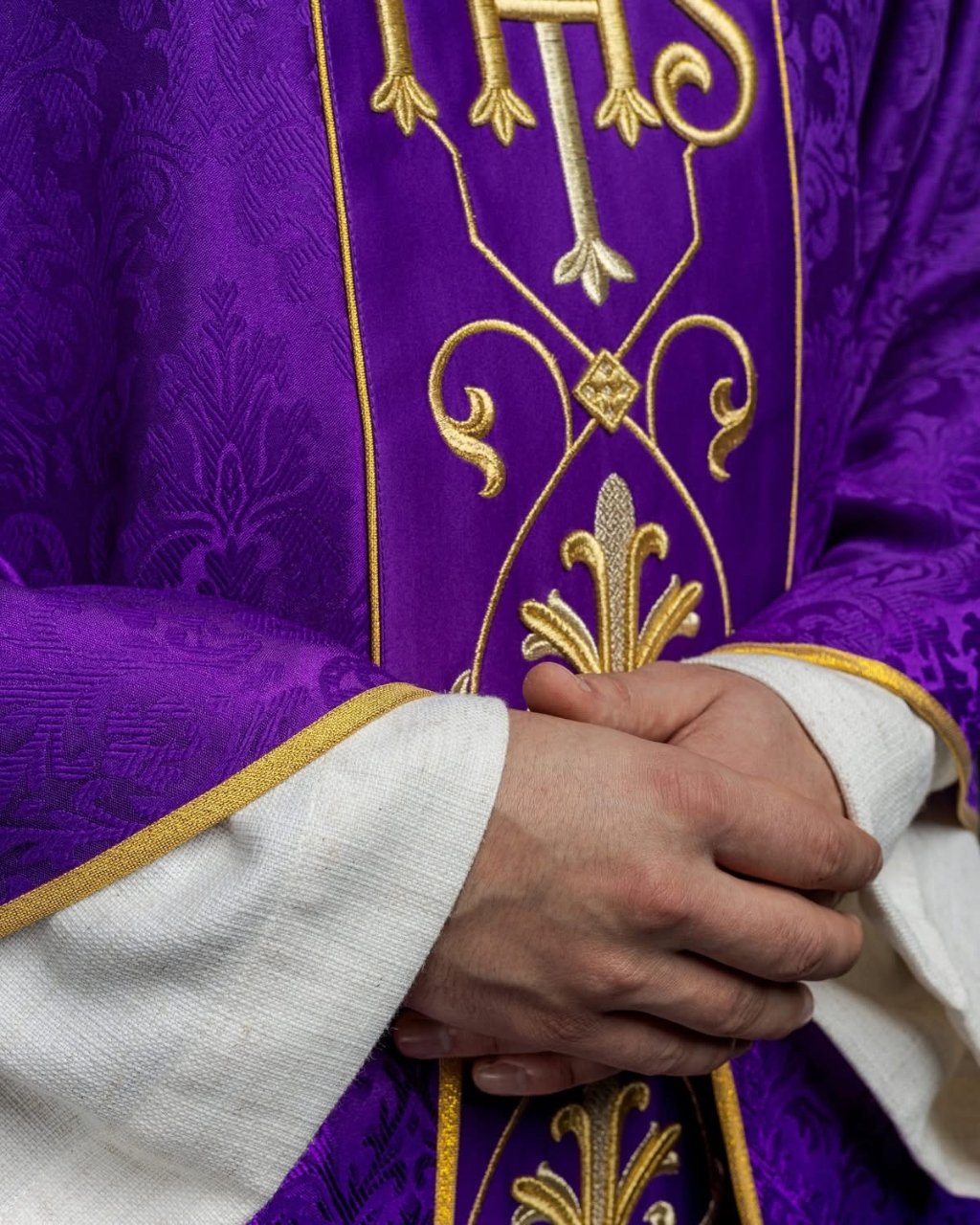The Importance of Liturgical VestmentsLiturgical vestments are not mere garments but sacred symbols that clothe the priest during the celebration of Holy Mass and other religious rites. Each vestment has a specific meaning and contributes to creating an atmosphere of solemnity and devotion. Helping the priest in the preparation of these vestments is an act of liturgical service that requires care, respect, and knowledge of their meaning.
Knowing the Liturgical Vestments: An Essential Glossary
Before you can assist the priest, it is essential to know the different liturgical vestments and their use. Here is a brief glossary:
- Amice: A rectangle of white linen worn under the alb to cover the neck and shoulders. It symbolizes the helmet of salvation and helps to conceal civilian clothing.
- Alb: A white tunic that reaches down to the ankles, worn over the amice. It represents the purity and innocence of the priest.
- Cincture: A white cord worn around the waist over the alb. It symbolizes chastity and temperance.
- Stole: A band of fabric in the liturgical color of the day, worn by the priest around the neck and draped down the front. It is the distinctive mark of the priest and deacon.
- Chasuble: The outer vestment worn by the priest during Mass. Its color varies depending on the liturgical season and symbolizes the charity that covers all sins.
In addition to these main vestments, there are other liturgical garments such as the cope (used for processions and other solemn celebrations), the surplice (similar to the alb but with narrower sleeves), the cassock (a long garment worn by altar servers), and the humeral veil (used to carry the Blessed Sacrament).
Specific Tasks to Assist the Priest
Assistance in the preparation of liturgical vestments can take the form of several tasks:
- Preparing the Vestments: Ensure that the vestments are clean, ironed, and in good condition. Check that no buttons are missing, that there are no tears or stains, and that the colors are vibrant.
- Arranging the Vestments: Before the celebration, arrange the vestments in order on the sacristy table or on the appropriate hanger. The typical order is: amice, alb, cincture, stole, and chasuble.
- Helping the Priest to Dress: Assist the priest in putting on the vestments, especially the chasuble, which can be heavy and cumbersome. Make sure the stole is positioned correctly and the cincture is tied securely.
- Storing the Vestments: After the celebration, carefully store the vestments in the sacristy closet, following the instructions of the priest or sacristan.
- Vestment Maintenance: Report any damage or cleaning needs of the vestments to the sacristan or priest. Sometimes, it may be necessary to hand wash or dry clean the more delicate vestments.
The Importance of Cleanliness and Care of Liturgical Vestments
The cleanliness and care of liturgical vestments are essential to maintain their decorum and dignity. Dirty or wrinkled vestments can distract the faithful and diminish the solemnity of the celebration. It is important to follow the manufacturer’s instructions for cleaning and storing the vestments. In general, it is advisable to:
- Wash the vestments by hand or dry clean, using mild detergents.
- Iron the vestments at a low temperature, protecting them with a cloth.
- Store the vestments in a dry and well-ventilated place, away from dust and direct sunlight.
- Use padded hangers to prevent the vestments from deforming.
The Role of the Sacristan and Other Liturgical Ministers
In many parishes, the care of liturgical vestments is entrusted to the sacristan, an important figure who is responsible for the maintenance and preparation of everything necessary for the celebrations. However, other liturgical ministers, such as altar servers and lectors, can also collaborate in assisting the priest and sacristan.
The Importance of Respect and Devotion
When handling liturgical vestments, it is essential to do so with respect and devotion. These vestments are sacred objects that are used to celebrate the mysteries of the faith. Treating them with care and reverence is a way to honor God and His Church.
Where to Buy High-Quality Liturgical Vestments
To ensure the dignity and beauty of liturgical celebrations, it is important to use high-quality vestments, made with fine fabrics and carefully finished. HaftinaUSA.com offers a wide selection of liturgical vestments, including sacred vestments, priestly chasubles, and other liturgical paraments. On our site, you can find:
- Priestly vestments made with fine fabrics and elaborate embroidery.
- Precious chasubles available in different liturgical colors and styles.
- A wide range of liturgical accessories, such as stoles, amices, and albs.
- Sacred paraments for all occasions, from ordinary times to the most important solemnities.
The Art of Embroidery in Liturgical Vestments
Embroidery is an ancient art that has always played an important role in the decoration of liturgical vestments. The embroideries can represent religious symbols, biblical scenes, or simply ornamental motifs. A well-executed embroidery can transform a simple vestment into a work of art. At HaftinaUSA.com, you can find embroidered liturgical vestments carefully crafted by expert artisans, who use traditional techniques and high-quality materials. Our embroidered sacred vestments are a true treasure of art and faith.
The Liturgical Colors and Their Meaning
The liturgical colors have a specific meaning and are used to indicate the liturgical season and the feast being celebrated. The main colors are:
- White: Symbolizes joy, purity, and glory. It is used during Eastertide, Christmastide, and in the feasts of non-martyr saints.
- Red: Symbolizes blood, fire, and love. It is used on Palm Sunday, Good Friday, Pentecost, and in the feasts of martyrs.
- Green: Symbolizes hope and life. It is used during Ordinary Time.
- Purple: Symbolizes penance and conversion. It is used during Advent and Lent.
- Black: Symbolizes mourning and death. It is used in Masses for the dead.
At HaftinaUSA.com, you can find liturgical vestments in all liturgical colors, for every time and occasion.
The Importance of Choosing the Right Liturgical Vestments
Choosing the right liturgical vestments is important to create an atmosphere of solemnity and devotion during the celebrations. The vestments must be suitable for the liturgical season, the feast being celebrated, and the personality of the priest. At HaftinaUSA.com, you can find a wide selection of liturgical vestments for all tastes and needs. Our team of experts is at your disposal to help you choose the most suitable vestments for your parish.
How to Take Care of Liturgical Vestments Over Time
To preserve the beauty and dignity of liturgical vestments over time, it is important to take care of them with attention. Here are some tips:
- Wash the vestments by hand or dry clean, following the manufacturer’s instructions.
- Iron the vestments at a low temperature, protecting them with a cloth.
- Store the vestments in a dry and well-ventilated place, away from dust and direct sunlight.
- Use padded hangers to prevent the vestments from deforming.
- Have any damage repaired by an experienced tailor.
With proper care, your liturgical vestments can last a long time and continue to honor the celebrations of your parish.
Why Choose HaftinaUSA.com for Your Liturgical Vestments
HaftinaUSA.com is your ideal partner for purchasing high-quality liturgical vestments. We offer a wide selection of products, competitive prices, and excellent customer service. We specialize in the sale of sacred vestments, precious chasubles, and other liturgical paraments. Our mission is to provide parishes and priests with the most beautiful and dignified vestments to celebrate the mysteries of the faith. Choose HaftinaUSA.com and discover the difference!
Conclusion
Helping the priest in the preparation of liturgical vestments is an act of liturgical service that requires knowledge, care, and respect. Understanding the meaning of the vestments, assisting the priest in putting them on, and taking care of their cleanliness and maintenance are all ways to contribute to the solemnity and beauty of the Eucharistic celebration. Remember that liturgical vestments are sacred symbols that remind us of the presence of God in our midst.

